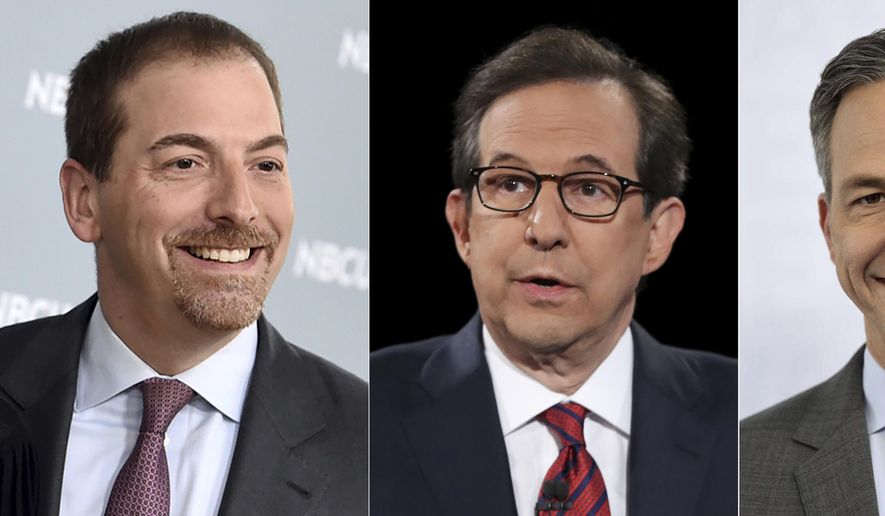Republicans and Democrats don’t agree on much, but a new poll found that most voters from both parties agree that the mainstream news media promotes a political agenda rather than reporting the facts.
The survey by the Trafalgar Group revealed that 76.3% of respondents from all political affiliations said that “the primary focus of the mainstream media’s coverage of current events is to advance their own opinions or political agendas,” compared to only 23.7% who said news media was interested in “finding and reporting the facts.”
Voters on both sides of the aisle have grown frustrated with the inability of national television and print media to give them the “undisputed facts” of what’s happening in the world rather than political spin, said pollster Robert Cahaly, who founded Trafalgar Group in 2016.
“People don’t know what’s true and they don’t want to be stupid, but different sources have different answers and it’s hard to figure out where to look anymore,” Mr. Cahaly said. “It’s the hiding of bias that creates distrust. It’s when you present something as ‘down-the-center’ that’s not.”
The poll showed that large majorities of likely Democrat, Republican and independent voters distrust the news media, though the share of Republicans that felt that way was much larger than the other two groups.
The survey is the latest in a series of reports that show an ongoing erosion of trust in mainstream media.
A March 2020 Gallup poll of 536 employed adults found that Americans ranked the media’s handling of the COVID-19 outbreak dead last in a list of nine institutions — with just 44% approving of the media’s handling of the pandemic, it was also the only institution to receive more negative than positive marks.
On April 3, the Media Bias Fact Check website downgraded the Jeff Bezos-owned Washington Post from a “high” factual rating to “mostly factual,” tagging it for “left-center bias” after the newspaper failed two fact checks.
And in June, the Reuters Institute for the Study of Journalism ranked the U.S. dead last in overall trust for the media among 46 nations with developed journalism industries.
The new Trafalgar poll found that 62.7% of Democrats, 76.1% of independent voters and 90.3% of Republicans believe opinions and political agendas drive the media’s coverage.
But while “mainstream media” for Republican voters means “distrusting everything that’s not conservative media, Democrats are talking about their own party,” Mr. Cahaly said.
“This poll confirms that the emperor has no clothes, most people are aware the bias exists, and the best way for media to deal with it is to just be honest,” he said.
He suspected that many voters are now confining themselves to local news as an alternative to national outlets and advocacy journalism websites.
“They still watch local TV news and read their local newspapers because they care about crime, sports and events happening in their hometowns,” Mr. Cahaly said.
James Carville, a Democratic strategist and former adviser to former President Bill Clinton, said the Trafalgar study also reflects an ongoing decline in traditional television and print media’s influence over voters.
“No one wants to say, ‘I read something in the newspaper and I believe it,’” Mr. Carville said. “To some parts of America, that makes you look like a fool. But if you read something on Facebook and believe it, it makes looks you look like a genius.”
Carrie Sheffield, a senior policy analyst at Independent Women’s Forum and former editorial employee at The Washington Times, said the trend is challenging mainstream media outlets to adjust their approach.
“News organizations should either shed their veneer of ‘objectivity’ and embrace their true advocacy nature or they should fire the partisan advocates and hire more objective workers,” said Ms. Sheffield.
Conservative media watchdogs have long accused the mainstream media of hiding a left-wing bias.
Ramesh Ponnuru, editor of the conservative National Review, said the higher distrust among Republican voters in the poll reflects a lingering perception on the right that large media outlets favor liberals in their coverage.
“Everyone involved in journalism knows that it is facing a crisis of trust, but there remains a lot of denial about the causes of that crisis, which include both an obvious political partiality to the left and a clickbait business model,” Mr. Ponnuru said.
But Adam Guillette, president of the nonprofit media watchdog Accuracy in Media, said the poll suggests many Democrats may also be bothered by left-wing distortions in the news.
“In these divisive times, it’s nice to see people coming together regardless of ideology with contempt for the mainstream media,” Mr. Guillette said.
He noted that some media outlets had damaged their credibility with “years of wish-fulfillment stories mocking President Trump and promising he’d go to jail.”
“We have two kinds of journalists today: activists who push an agenda and fan fiction journalists – like CNN and the New York Times – who just write clickbait headlines telling their audience what they want to hear,” Mr. Guillette said.
Mirroring likely voter turnout demographics, 39.3% of respondents in the poll identified as Democrats, 35.6% as Republicans and 25.1% as independents. The margin of error was plus or minus 2.98% at the 95% confidence level.
Mr. Cahaly said the poll reflects an ongoing trend in which independent voters are “inching closer to Republicans” on all issues the firm has polled in recent months.
The firm distributes its survey questionnaires using a mixed methodology of live callers, integrated voice response, text messages, emails and two other proprietary digital methods that it doesn’t share publicly.
According to Trafalgar, the survey of 1,084 likely general election voters was conducted Dec. 4-7. The poll was conducted on behalf of the nonprofit Convention of States Action, which advocates for returning federal powers to the states.
• Sean Salai can be reached at ssalai@washingtontimes.com.




Please read our comment policy before commenting.